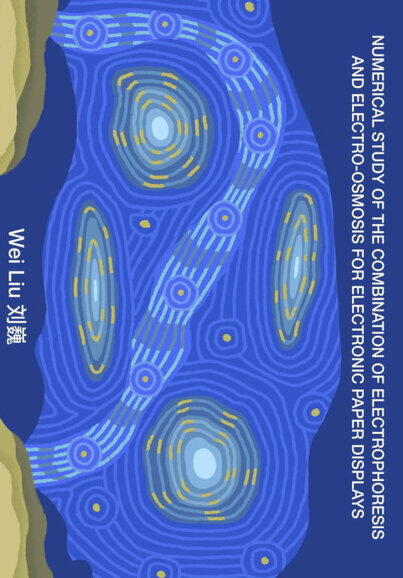Numerical study of electrophoresis and electro-osmosis for electronic paper displays
Wei Liu defended his PhD thesis at the Department of Mechanical Engineering on May 15th.

Electrophoretic displays, known for their paper-like appearance and low power usage, have emerged as strong contenders for electronic paper applications. These displays leverage the electrophoretic principle, where differently colored charged particles move in a solution within fluidic cells in response to an electric field. This movement creates visual representations that can be used in various electronic display applications. However, a significant challenge with this technology is the limited speed at which the particles can move to different positions within the fluidic cells. In his PhD thesis, Wei Liu delved deeper into into the physics underlying the combined effect of electrophoresis and electro-osmosis on the motion of the particles and the fluid within the cells and propose strategies for developing a rapidly switching electrokinetic display.
Currently, the typical time scale for switching in electrophoretic displays is limited to approximately 300 ms (milliseconds), which is not suitable for applications requiring faster refresh rates, such as video playback. This limitation has hindered the widespread use of electrophoretic displays in areas where quick visual updates are crucial.
To address this limitation, explored novel display principles that combine electro-osmosis and electrophoresis in these systems for his PhD research. Electro-osmosis refers to fluid motion in response to an applied electric field, which can potentially enhance the particle velocities and, therefore, the switching speed of electrophoretic displays.
The ultimate goal of Liu鈥檚 research was to increase particle velocities by boosting fluid motion, thereby expanding the application of electrokinetic displays to include video applications, where faster refresh rates are essential.

Robust model
To achieve his goal, Liu developed a robust physical model based on the Butler-Volmer equation to investigate how charges are generated, and found that they are generated by both electrochemical and bulk reactions.
By performing numerical simulations to investigate the combined effects of electrophoresis and electro-osmosis, Liu also found that electro-osmosis plays an important role in particle motion. Based on the conclusions from these studies, he numerically investigated the influence of Zeta potential patterns and electrode design on enhancing the contribution of electro-osmosis for fast-switching electronic paper displays.
In addition, Liu observed that an out-of-plane electrode configuration with a negative-negative Zeta potential pattern exhibited the shortest switching time.
Finally, by experimentally quantifying switching times through simple intensity measurements, he explored the impact of cell geometry and various other experimental variables. In the process, he successfully rationalized the experimental results by leveraging numerical simulations that encapsulate the governing physical mechanisms.
Intricate interplay
This study uncovers the physics underlying fluid motion and the intricate interplay of electrokinetic effects that govern particle motion in the liquid.
Liu predicts that the results from his research will offer valuable insights into improving particle transport in electronic paper displays and other applications that harness the combined effects of electrophoresis and electro-osmosis.
Furthermore, this study is significant for fundamental research in particle manipulation and fluid dynamics within intricate electrokinetic systems, thus advancing the broader field of knowledge.
Title of PhD thesis: . Supervisors: Hans Wyss, Jaap den Toonder, and Alex Henzen.